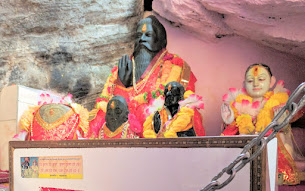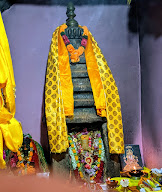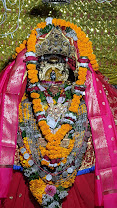Day – 3 (07/11/2024)
Our second day's itinerary: Rudra Prayag, Karna Temple, Bairaskund, Lakshmi Narayana Temple - Gulabkoti, Kalpeshwar, Dhyan Badari, Vrudh Badari, Joshimath Night Halt. Unfortunately, due to time constraints, we had to drop Karna Temple, Kalpeshwar, Dhyan Badari & Vrudha Badari, from the second day's plan but we visited all of these (except Karna Temple) in the subsequent days.
Recap of second day's places of visit: Karna Prayag, Bairaskund & Lakshmi Narayana Temple -Gulabkoti and reached Joshimath's Neelkant Hotel for the night halt.
Plan for the third day: Narasingh Mandir, Dronagiri View Point, Bhavishya Badari, Auli Hanuman Mandir, Vishu Prayag, Yogdhyan Badari, Kuber Temple, Badari Kshethra (Shayana Aarti) and night halt. Tall order this. Let's see what can we achieve!
Hop on with us for a virtual tour of our Day 3 activities.
This morning, after our first routine of coffee and bath, we shifted the bigger luggage to one of the rooms we retained, as we intended to return to this place after our Badari Yaatra. The previous evening, we had packed our 2-3 sets of clothing and other stuff to take us through for the next night and two days and packed it into our 'limousine'.
First, we went to Narasimha temple to witness the abhisheka to the main deity. The deity’s Saligrama idol is a sight to behold! The left hand of the deity has grown thin and legend goes that if it shrinks fully, both Badri and Kedarnath will become inaccessible.
Alongside this, there are a few other idols too of Kubera, Uddhava, Hanuman, Ganesha, Garuda, etc. There is a Maa Lakshmi temple opposite this main temple.
Once Badari
closes for the winter, the deity from Badari is housed in this temple and pooja will be performed for the next six months till the temple in Badari reopens.
Sequentially, they were Lord Badari Narayana (below the Lord is Garuda), His mother Maata Murti, further Brahma, Vishnu, Maheshwara, Hiranya Kashyapu, Nag and Nagin, Shiva & Parvati, Narasimha, Suryanarayana, Kali Maa, Ravan, Rama, Lakshmana, Seetha, Swarna Mriga and few unidentified ones. The lock of hair of Goddess Durga can be seen too.
From here we moved on to Tapovan, where we had our breakfast while waiting for our smaller vehicle to take us to Bhavishya Badari (future Badari) near Subhai. In the years gone by, there was no motorable road to this place and one was forced to trek around 14 km from Tapovan. As the prophecy goes, the existing Badari would become inaccessible and this would replace it.
After an easy climb of 300 mts, we reached the temple and beheld the swayambhu (self-forming) idol of the Lord.
For comparison of how the idol has been evolving since it was discovered, Suma Aunty had a copy of the idol’s picture taken by her in 2010 (first three pics) and also the view of the temple's entrance then, when she visited over a decade ago and now is clearly distinguishable. We could distinctly see the features being formed, particularly of the hands on the Lord's idol and also that of Kali and Ganesha alongside. Also being formed is the idol of Maa Lakshmi (identifiable as a crown placed on her head). One of the legs is partially visible while the other is being formed. There is water under the idol where the feet are being formed although there is no source of it near the temple.
We performed pooja through the priest here, offered naivedya and clad it with the traditional ‘shalya’ as was being done in all the temples we visited.
Just 2 km down the hill is the temple housing Lakshmi Narayana. We had a chat with the priest over there and he narrated that Adi Shankara who installed the idols here suggested that a temple be built for the idols as this place will occupy the importance of Bhavishya Badari. The ancient idols were removed from the old building and placed in a temporary structure as the main temple is under construction in place of the old temple building. This temple is a part of the Badari-Kedar Administration and follows the same rules as is prevalent there. Though this was supposed to be the Bhavishya Badari, the Lord had different plans as he chose the place a bit higher in the mountains than the one that was thus readied.
Below is the picture of Lord Lakshmi Narayana.
Skipping
our lunch, we proceeded past Badarinath to Mana village – hitherto known as the
last village of India. This was corrected to be perceived as the ‘First Village
of India’ by the current government. From the parking spot, we went on foot through the footway that had various shops selling their woolen wares and tea, etc., on either side. We came to a fork where one led to the caves of Lord Ganesh and Maharshi Veda Vyasa while the other led to the place of origin of the Saraswathi River that joins the Alakananda River downstream. We took the second one to see the origin of the Saraswathi river where we could see the roaring river flow down. The lovely idol of Goddess Saraswathi is located close to this and also in a temple dedicated to her with idols of Lords Dattatreya, Vittala and Goddess Rukhmayi,
Sants Meera, Tukharam and Tulsidas. There is an idol of Maharshi Vedavyas at the entrance of this temple.
Then we visited the caves alluded to earlier. Maharshi Vyasa's cave (gufa in Hindi) is a prominent one. It was here that the Maharshi Vyas narrated the story of Mahabharata to Lord Ganesh who wrote it on palm leaves. The first three pics were taken by Suma Aunty in 2016. The condition put forth by Lord Ganesha was that Maharshi Vyas must not stop narrating at any point. It is said that the Lord wrote brisky with both hands. The Sage agreed and put a counter-condition to the Lord that he will narrate the Shlokas and the Lord must write it down with all attention towards the meaning and substance of it. Maharshi Vyasa scripted many Puranas and other scriptures here, on palm leaves. It is believed that these leaves are still in existence and since it was feared that the scriptures on the leaves would be stolen, he converted all those into stones. We can see the rock formed in layers even now, signifying the presence of these leaves. The original idols of Vishnu, Vedavyas, Shukacharya and Vallabhacharya are still found in this cave and a new idol of Vedavyas has been installed. A few hundred steps down this cave is Lord Ganesha's cave, which houses his idol too. Pictures of the same can be seen below.

.jpeg)





It was getting late for our scheduled Shayan Aarti and we rushed towards Badarinath. We checked into Hotel Charan Paduka for the night, refreshed and started towards the temple for our appointment with the Lord.
Just before that, we met with the Pandits who would guide us in performing the Pinda Pradhaan the next morning. Suma Aunty had pre-arranged for this through her known sources. Quite a resourceful lady!
As mentioned earlier, this was my first visit to these places and I was still in awe of all these places. What a sight it was to see the Badarinath Temple in all its glory and lighting! We walked our way through a steep climb down towards the entrance and crossed the bridge over river Alakananda while feasting our eyes on the splendour of the temple!











.jpeg)



While waiting for the Shayana Aarti, we met a young lady, Suman and her daughter Srishti. They were enquiring about the seva one can do here and other related information and we guided her to check with the Ticketing Office. Apparently, they are from nearby Srinagar (near Rudra Prayag) now settled in New Delhi. Incidentally, this was their first trip to Badarinath. Despite the crowd, we bumped into each other almost half a dozen times during our short stay in Badari for a night and half a day, despite the reasonable thick crowd. Providence!
We managed to have Darshana of the Lord Badarinath a couple of times before we were called out to assemble in front of the Lord for the Shayan Aarti.
The magical
moment to be with the Lord finally arrived!
The reverberating sounds of bells during the Shayana Aarti filled the sanctum sanctorum and are still ringing and fresh in my ears! Oh, by the way, no photography is allowed in the sanctum of the temple and a person who braved to test the rule by taking a picture of the Lord, was relieved of his mobile phone instantly, by the authorities. The crowd beheld the Vishwaroopa Darshana of the Moola Moorthy of Lord Badarinath, anointed with sandal paste as the alankaras were removed.
A bit of a tale about the night Anil and I spent in our room – There were neither enough warm blankets nor was equipped with a heater. Additionally, sometime around 1-ish, we heard someone grunting or snoring so loudly that I woke up with a start to find the origin of this monstrous decibel of a sound. It was like a pig’s loud grunt (I don't think there are pigs here) but sounded like a snore. I discovered an open window behind the movable wardrobe and shut it to give us some relief from the bitter cold and the sound. Well, the temperature was close to a negative number that night.
Plan vs. Actual:
We couldn't visit Dronagiri View Point, Auli Hanuman Mandir, Vishu Prayag, Yogdhyan Badari, Kuber Temple, due to paucity of time, nevertheless, as an out-of-syllabus activity, we visited Mana village and the places it held (Saraswathi river's origin, Maharshi Vyas Gufa and Lord Ganesh Gufa). We planned to visit Hanuman Chatti, Yogdhyana Badari and a few others on the return to Joshimath.
----------------------------------------










.jpeg)

.jpeg)


















.jpeg)

.jpg)
No comments:
Post a Comment